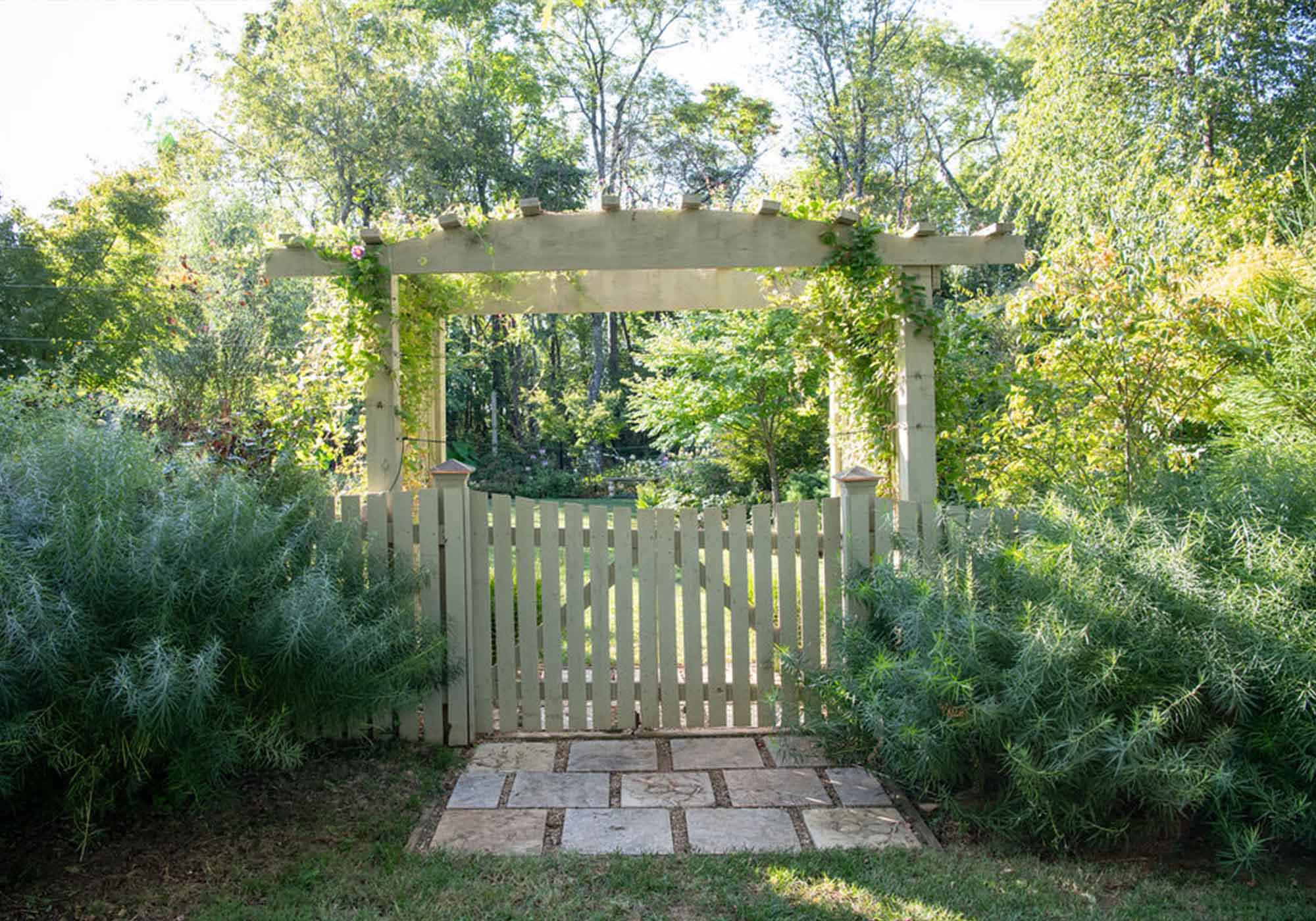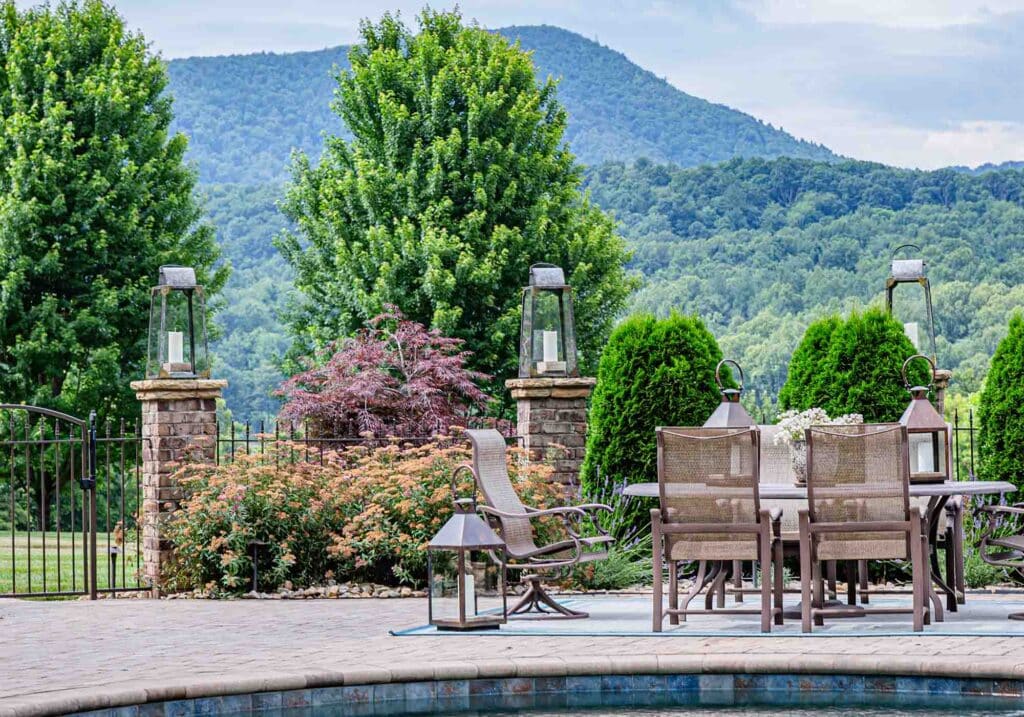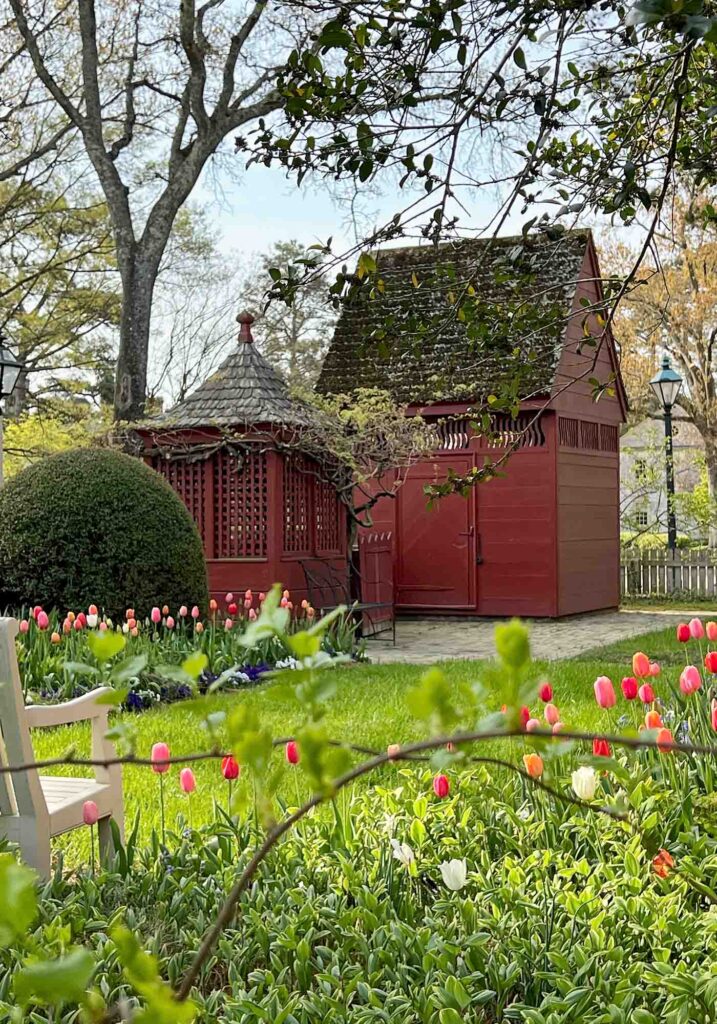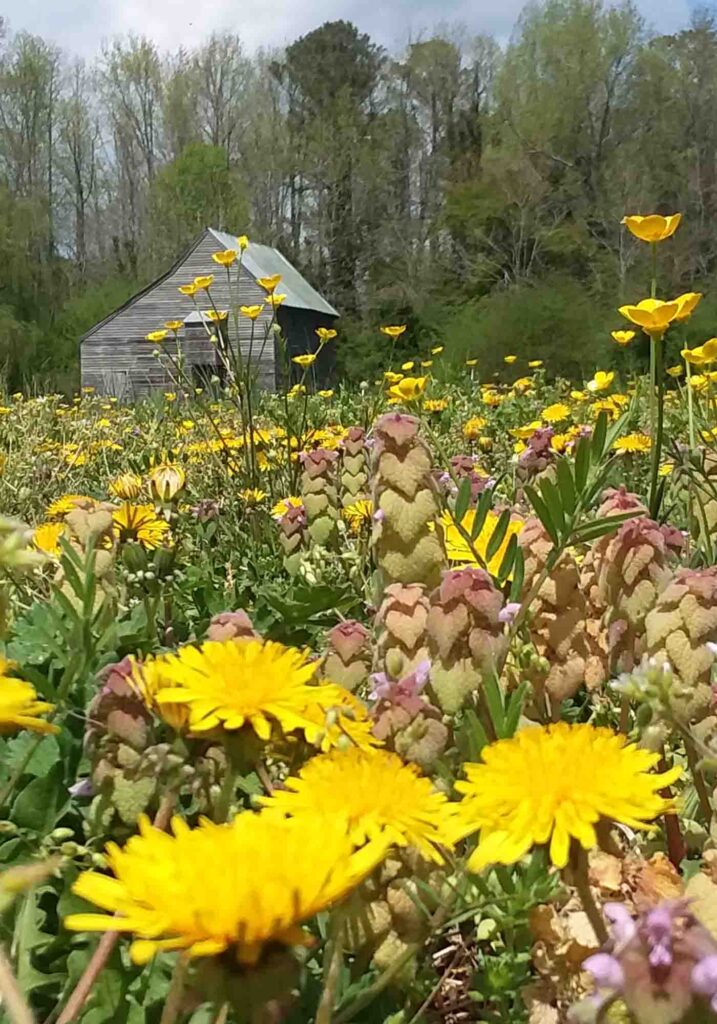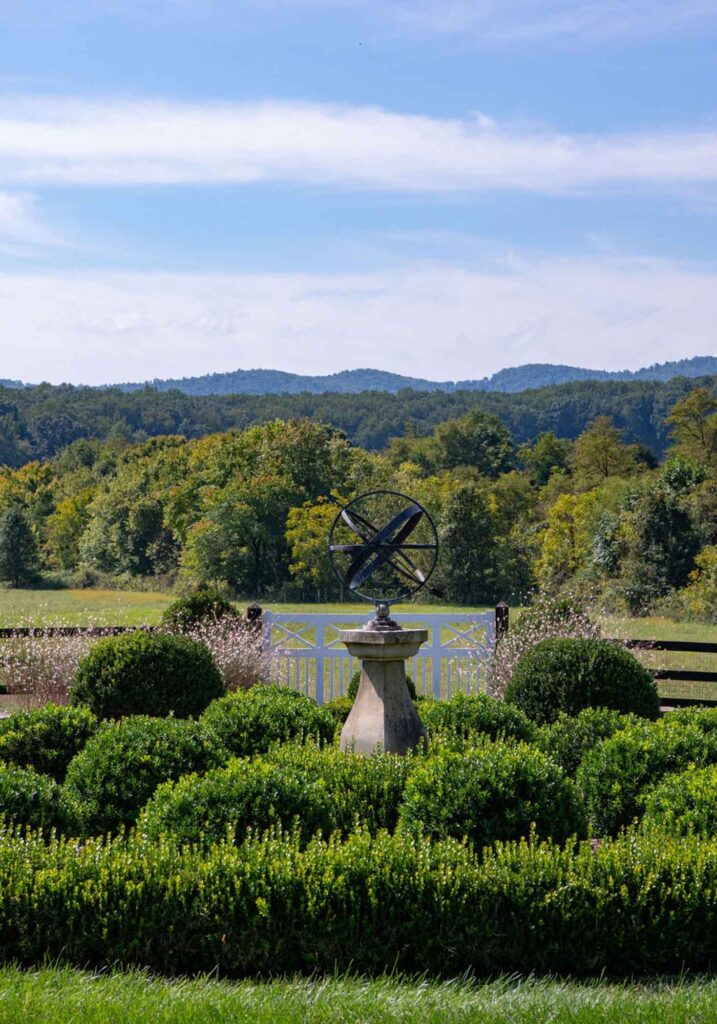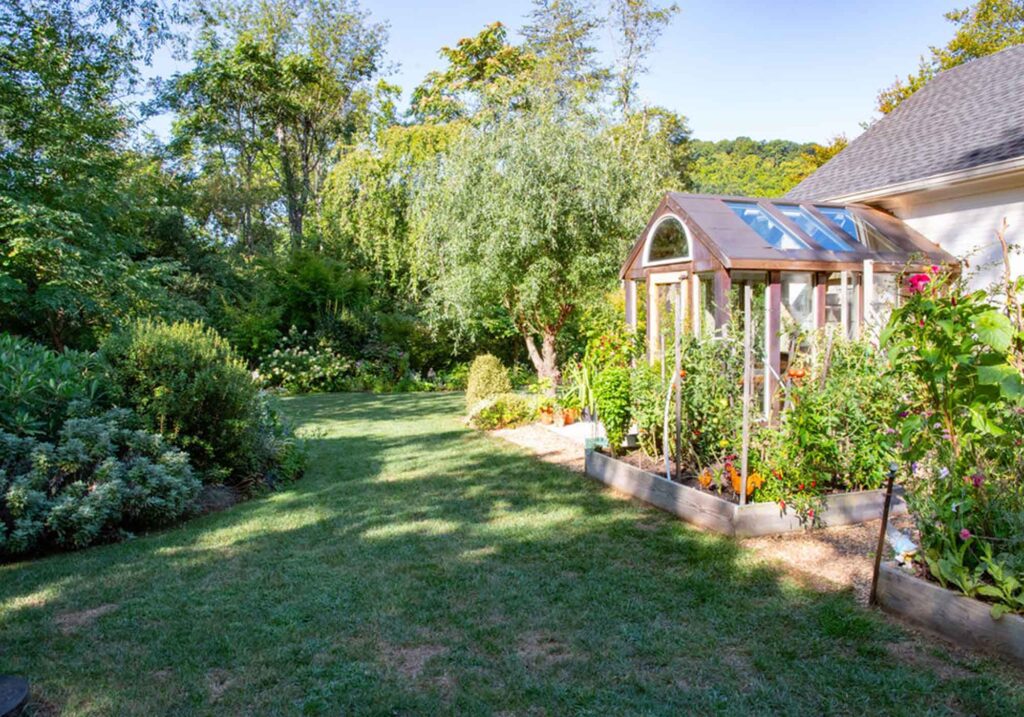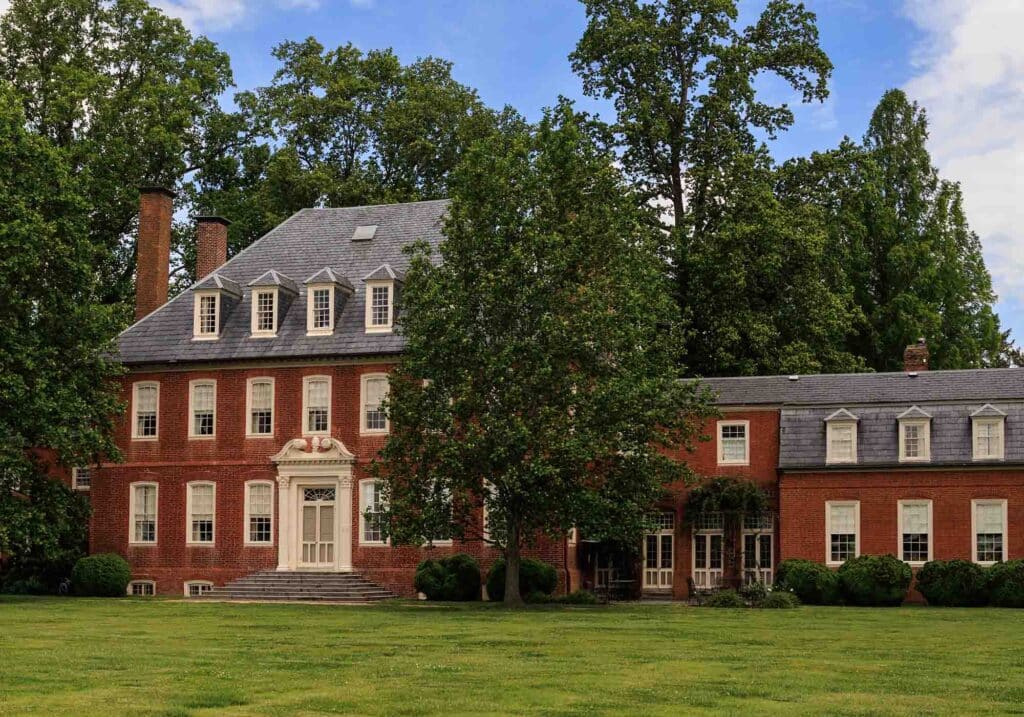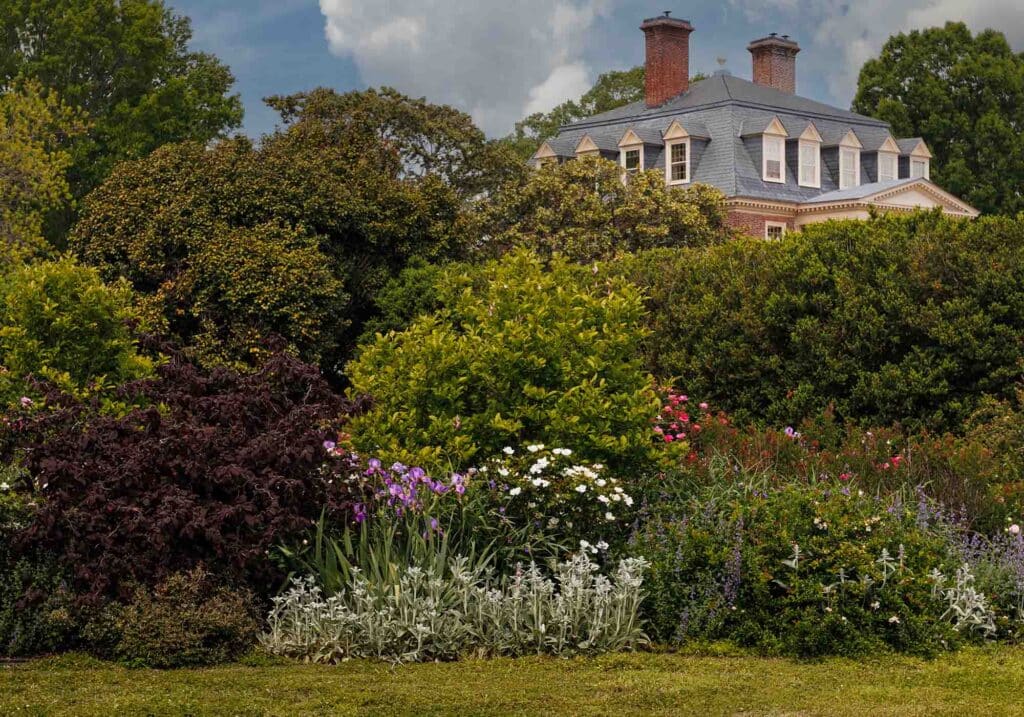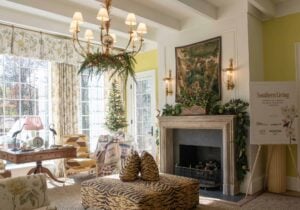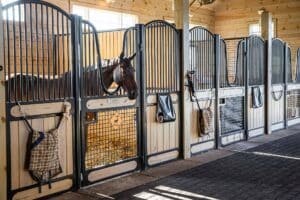Each spring, the Garden Club of Virginia (GCV) hosts Historic Garden Week (HGW), a highly anticipated event. As a result, visitors are invited to explore the Commonwealth’s historic homes, gardens and landscapes. Nearly 50 member clubs organize the statewide tour, offering a rare opportunity to explore private properties that are typically closed to the public. In turn, visitors can enjoy beautifully restored homes, vibrant gardens and elaborate floral arrangements created by club members. The Garden Club of Virginia uses proceeds from the event to preserve and restore historic gardens throughout Virginia. Established in 1929, Historic Garden Week is often called “America’s Largest Open House.”
Regional Garden Clubs of Virginia
North | South | East | West | Central
2025 Historic Garden Week Tour Schedule
North
- Old Town Alexandria
- Clarke County-Winchester
- Front Royal-Warren County
East
- Gloucester-Mathews
- Franklin
West
- Staunton
- Morven/Albemarle County
Central
- Ashland-New Kent
North
- Middleburg
West
- Albemarle County
East/Central
- Historic Berkeley, Shirley & Westover
North
- Middleburg
West
- The University of Virginia
East/Central*
- Historic Berkeley, Shirley & Westover
East
- Williamsburg
West
- Lynchburg
Central
- Petersburg
- Fredricksburg-Falmouth
- Richmond: Lower Tuckahoe, West
North
- Warrenton
South
- Martinsville
East
- Hampton-Newport News
- Virginia Beach
West
- Harrisonburg
Central
- Northern Neck
- Richmond: Pope Avenue
South
- Danville-Chatham
East
- Norfolk
Central
- Richmond: Chatham Hills
East
- Middle Peninsula-Middlesex County
Central
- Executive Mansion and the Kent-Valentine House (GCV Restoration Sites open to the public)
South
- Roanoke
East
- Eastern Shore
West
- Lexington
Historic Garden Tours in Northern Virginia
Clarke County, Virginia: Historic Estates and Rural Heritage
Clarke County separated from Frederick County in 1836. Today, the site, nestled in the scenic Shenandoah Valley, is renowned for its preserved rural charm and agricultural legacy. The county flourished in the 19th century and it remains a showcase of historic architecture and equestrian tradition. The tour consists of prominent estates such as Long Branch, a stately Greek Revival mansion; Fairview, an antebellum property linked to Virginia’s elite families; and Montevento, a working farmstead with deep agricultural roots.
Front Royal, Virginia: Civil War History and Historic Districts
Front Royal, the seat of Warren County since 1836, was established in 1788 and is steeped in Civil War history and natural beauty. The town gained prominence during the 1862 Battle of Front Royal, a key engagement in Stonewall Jackson’s Shenandoah Valley campaign. The National Register of Historic Places includes the Front Royal Historic District. It showcases architecture spanning the 18th to 20th centuries. The tour will explore the Rockland Rural Historic District spanning over 10,000 acres of farmland and estates.
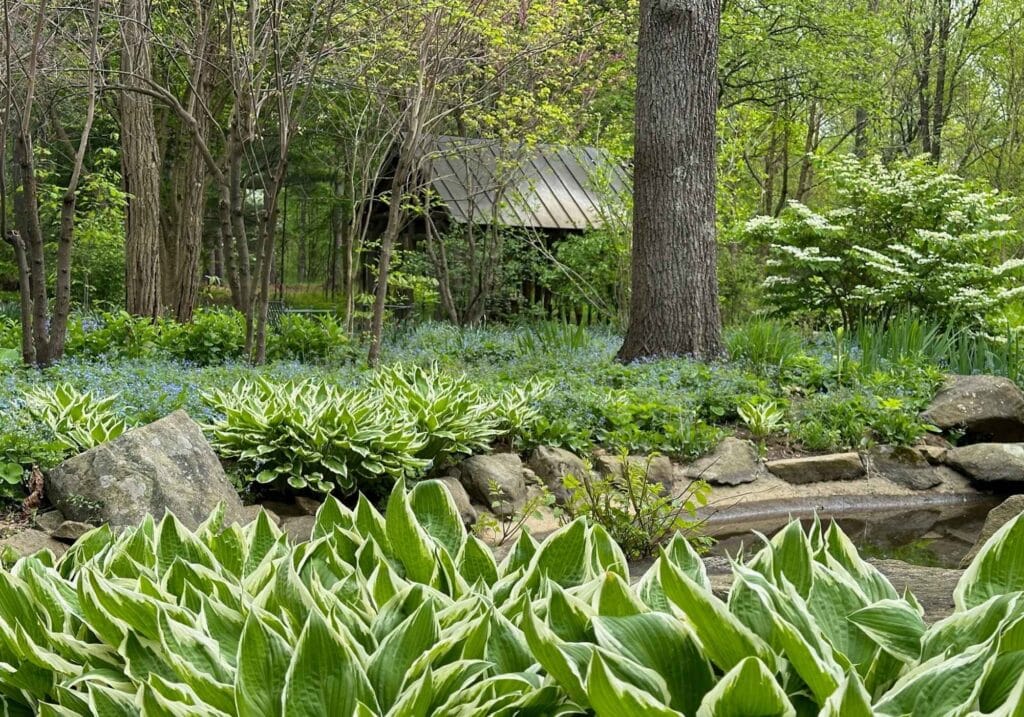
Middleburg, Virginia: Equestrian Tradition and Architectural Elegance
Middleburg is celebrated for its deep equestrian roots and well-preserved historic estates. One such estate on the 2025 Historic Garden Week Tour is Benton, or Spring Hill, built circa 1831 by master brickmaker William Benton, who also worked on President James Monroe’s Oak Hill. The National Register of Historic Places recognizes Benton as a cornerstone of Middleburg’s architectural legacy. Also featured on the tour are Ellerslie—recognized by the Smithsonian Archives of American Gardens—and The Pond House, known for its rich natural landscapes of meadows and woodlands. Middleburg’s heritage shines through these charming and culturally significant properties.
Alexandria, Virginia: Colonial History and Restored Garden Landmarks
Alexandria blends colonial heritage with a vibrant modern identity, all while preserving its historical roots through iconic landmarks. Among them are the meticulously restored gardens at George Washington’s Mount Vernon Estate and the historic horticulture of Green Spring Gardens, both Garden Club of Virginia Restoration Sites. These destinations feature 18th-century garden designs, walled landscapes, and educational programs, offering a rich experience for history and garden enthusiasts. Alexandria’s historic charm is further highlighted through its secluded private gardens and luxury townhomes featured on the walking tours during the 2025 Historic Garden Week tour.

Warrenton, Virginia: Civil War Legacy and Historic District Treasures
Visitors to the Historic Garden Week events can take a driving tour through Warrenton, founded in 1810 and named after Revolutionary War figure Gen. Joseph Warren, began as a crossroads market known as the Red Store. Over time, it developed into a civic hub. The town’s strategic location made it a focal point during the Civil War, changing control at least 67 times. Today, the Warrenton Historic District includes more than 300 historic properties. It was recently expanded in 2024 and is listed on the National Register of Historic Places. Notable sites include the 1890 Fauquier County Courthouse and the 1758 Paradise estate—testaments to the town’s storied past.
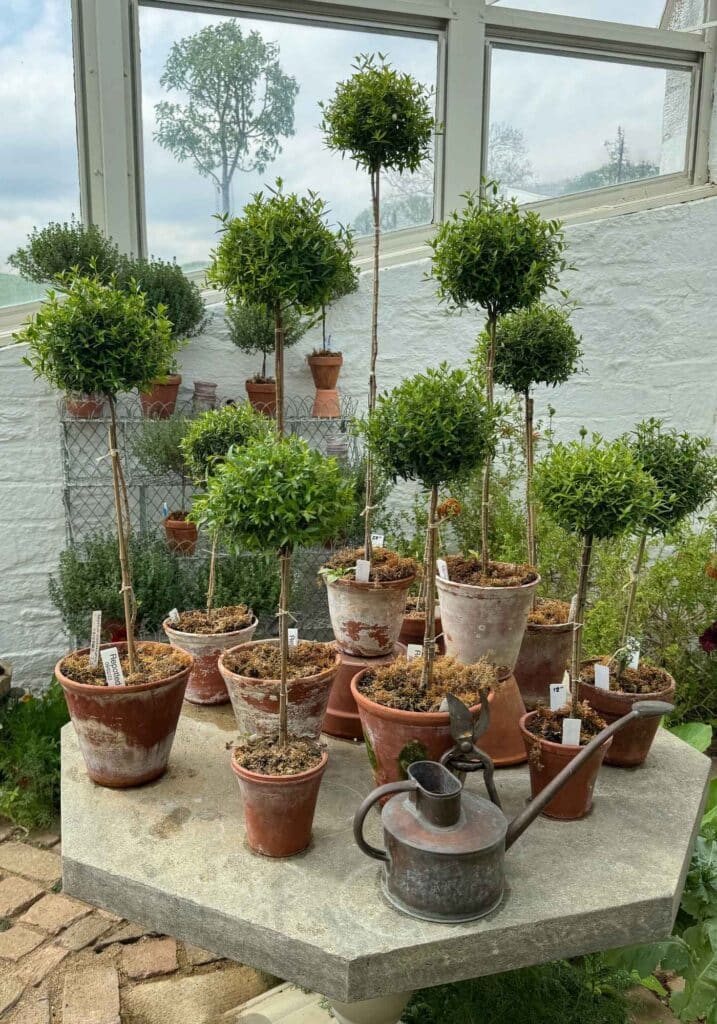
Little Oak Spring, Upperville, Virginia: Mellon Legacy and Garden Mastery
Little Oak Spring is a historic estate that once formed part of Rokeby Farm, home to philanthropists Paul and Rachel “Bunny” Mellon. Designed by architect H. Page Cross, Bunny Mellon crafted world-class gardens and designed whitewashed stone buildings for the estate, including terraced landscapes, a formal greenhouse, and a serene walled garden. Also on-site is the Broodmare Barn, where Mellon bred the Kentucky Derby winner Sea Hero. Little Oak Spring offers a rare glimpse into American garden design and thoroughbred racing heritage.
Historic Garden Tours in Southern Virginia
Roanoke, Virginia: Historic Charm in the Blue Ridge Mountains
Nestled in the heart of the Blue Ridge Mountains, Roanoke, Virginia, offers a compelling mix of historic character, natural beauty and cultural vibrancy. Known for its railroad and industrial past, Roanoke has since reinvented itself as a hub for arts, outdoor recreation and sustainability. This year’s Historic Garden Week tour highlights this transformation through visits to private residences, a floral design workshop, and pollinator gardens, including active beehives. The immersive stops showcase the city’s ongoing commitment to green living and creative expression.
Martinsville, Virginia: Architecture and Legacy in the Foothills
Martinsville, named after Revolutionary War General Joseph Martin, is a city steeped in history and architectural richness. As part of the 2025 Historic Garden Week tours, visitors will explore Stoneleigh, a stately Tudor-style mansion built in 1926 from native Smith River stone. Once the home of Virginia Governor Thomas B. Stanley, Stoneleigh exemplifies the area’s tradition of craftsmanship and elegance. Also featured is Hillcroft, the oldest standing residence in Henry County. This early 19th-century home offers a rare glimpse into the region’s architectural past and rural roots.
Danville-Chatham, Virginia: Southern Grandeur and Civil War History
Danville and nearby Chatham showcase a wealth of architectural and historical treasures, particularly in Danville’s South Side neighborhoods. The centerpiece of the 2025 Historic Garden Week tour is “Millionaires’ Row,” a stretch of Main Street lined with opulent Victorian and Edwardian mansions. These homes reflect a diverse range of 19th-century styles. Notable examples include Italianate, Queen Anne, Gothic Revival, and Richardsonian Romanesque architecture. The tour also features the iconic Sutherlin Mansion, a stately Italianate residence built in 1859 that famously served as the final seat of the Confederate government in April 1865. Today, the mansion houses the Danville Museum of Fine Arts and History, offering visitors a deeper understanding of the region’s cultural and political legacy.
Historic Garden Tours on the Eastern Shore of Virginia
Franklin, Virginia: A Historic Hub on the Blackwater River
Franklin, Virginia, was incorporated in 1876. It became a key commercial hub in southeastern Virginia due to its strategic location on the Blackwater River and expanding railroad networks. The city’s historic Clay Street, one of its main thoroughfares, serves as a focal point for visitors seeking to explore its rich past. Nearby, Virginia’s Eastern Shore, part of the Delmarva Peninsula, boasts a distinct geography bordered by the Chesapeake Bay and the Atlantic Ocean. With historic towns like Onancock and Cape Charles, the Eastern Shore preserves its centuries-old coastal life, highlighted through private properties and historic farms open for touring.
Gloucester, Virginia: A Journey Through Colonial and Civil Rights History
Steeped in both colonial and civil rights history, Gloucester, Virginia, offers a glimpse into Virginia’s architectural heritage. This year’s tour features The Exchange, an early 1700s home, and Blythelea, both nestled along the North River with well-preserved gardens that exemplify the region’s charm. One standout site is Holly Knoll, a grand Georgian-style home built in 1935. It sits along the scenic York River. This landmark served as the retirement home of Dr. Robert Russa Moton, the second president of the Tuskegee Institute. Designated a National Historic Landmark in 1981, Holly Knoll became a gathering place for civil rights leaders and now operates as the Gloucester Institute, fostering future African American leaders.
Williamsburg: Historic Charm Meets Residential Expansion
Known for its pivotal role in early American history, Williamsburg, Virginia, is home to the meticulously preserved Colonial Williamsburg, a living-history museum that recreates 18th-century life. This year’s Historic Garden Week tour includes the Indian Springs and Burns Lane neighborhoods. Visitors will see four mid-20th-century homes that highlight Williamsburg’s growth beyond its colonial core. As a result, guests will experience a unique blend of history and modern charm with access to rarely-publicized properties and four staffed gardens, highlighting Williamsburg’s ongoing commitment to preservation and community character.
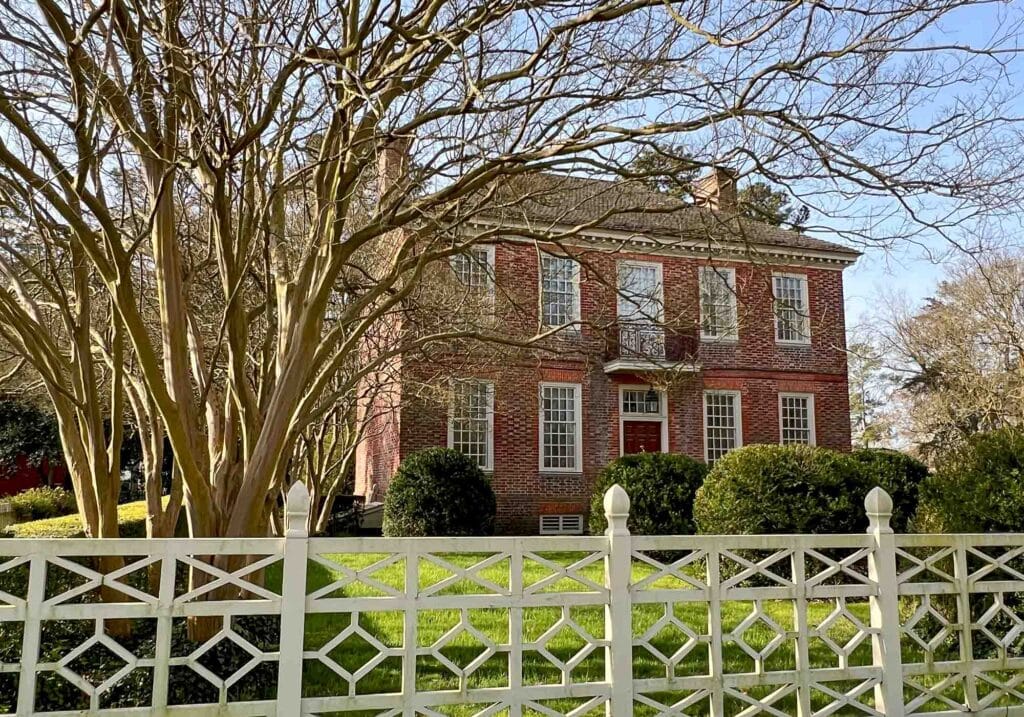
Hampton and Newport News: A Blend of History and Culture
Hampton and Newport News, two cities steeped in history, feature neighborhoods and landmarks that showcase their rich cultural heritage. This year’s tour highlights the Historic Little England community, originally developed in 1888 as a “streetcar suburb” with Queen Anne and Colonial Revival architecture. Additionally, the tour showcases Merrimac Shores, a 1940s waterfront neighborhood. It overlooks the historic site of the Battle of the Monitor and Merrimac and features diverse architectural styles and stunning views. A standout is the restored 1920 Hampton Carousel, one of only 170 antique wooden merry-go-rounds still in existence, offering a nostalgic experience with its original band organ and finely carved horses.
Virginia Beach: Coastal Heritage and Community Traditions
Virginia Beach, known for its coastal charm, also boasts a rich history interwoven with community traditions. The Historic Garden Week tour headquarters are located at the Princess Anne Country Club, a central social and recreational hub. The club hosts the annual Garden Market, featuring over 100 vendors and attracting visitors to its scenic grounds. This event, along with others throughout the city, highlights Virginia Beach’s unique blend of history, culture, and coastal beauty, offering a perfect blend of nature and heritage for residents and visitors alike.
A standout is the restored 1920 Hampton Carousel, one of only 170 antique wooden merry-go-rounds still in existence, offering a nostalgic experience with its original band organ and finely carved horses.
Norfolk: Historic and Vibrant Waterfront City
Norfolk, Virginia, established in 1682, has long played a pivotal role in American history as a center of commerce, shipbuilding, and naval operations. Located at the mouth of the Chesapeake Bay, Norfolk is home to the world’s largest naval base, Naval Station Norfolk. The city, which has rebuilt itself several times after being burned during the Revolutionary War and suffering heavy damage during the Civil War, is now known for its vibrant waterfront and historic neighborhoods. This tour includes a walking tour of five historic properties in Norfolk’s Lakewood area, offering visitors a chance to explore the city’s rich cultural and architectural history.
Middlesex County: A Snapshot of Colonial and Agricultural Heritage
Virginia’s Middlesex County, situated on the Middle Peninsula between the Rappahannock and York rivers, is a region rich in colonial history and rural charm. Known for its agricultural heritage and preserved estates, Middlesex offers an authentic glimpse into the past. Notable homes featured on the tour include Cupalow, a classic Tidewater plantation house with Federal-style architecture, and San Souci, a 19th-century riverfront retreat. Providence, a well-preserved 18th-century home, rounds out the tour. It reflects the region’s enduring legacy of plantation life, maritime culture, and historic preservation.
Historic Garden Tours of Western Virginia
Staunton, Virginia: Frontier Roots and Shenandoah Valley Charm
Nestled in the heart of the Shenandoah Valley, Staunton, Virginia, is celebrated for its rich architectural history and cultural heritage. The birthplace of President Woodrow Wilson, Staunton played pivotal roles in both frontier expansion and the Civil War. This year, the 2025 Historic Garden Week tour extends into nearby Mount Sidney—one of the best-preserved 19th-century villages in the region—and Fort Defiance, named after a frontier fort from the Indian Wars era. With its vibrant downtown and preserved historic districts, Staunton remains a key destination for history and architecture enthusiasts.
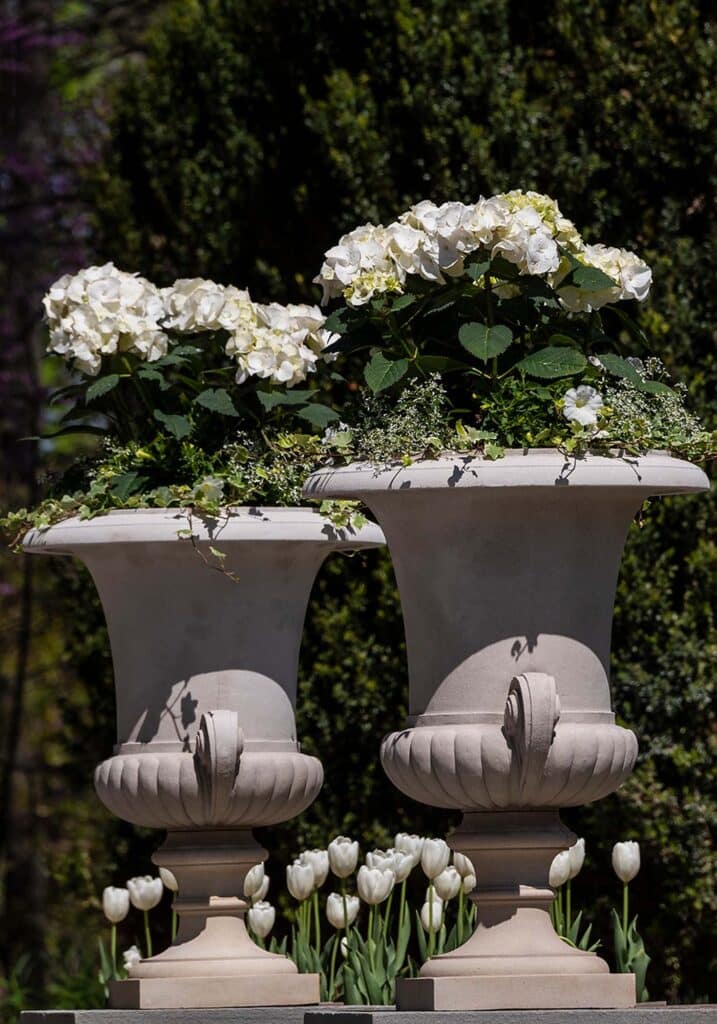
Morven Estate: A Garden Club Legacy in Albemarle County
Morven, a historic estate in Albemarle County, is a shining example of Virginia’s horticultural and architectural legacy. Builders constructed the Federal-style home around 1820, and it now sits surrounded by stunning Colonial Revival and Japanese-style gardens. Morven was one of the original properties showcased during the first Historic Garden Week in 1929. Its legacy deepened when then-owner Josephine Marshall became the first president of the Albemarle Garden Club in 1919. Today, Morven continues to welcome visitors during Garden Week, offering an immersive glimpse into its timeless beauty and enduring connection to the Garden Club of Virginia.
Albemarle County: Historic Landscapes and Mountain Heritage
Albemarle County, home to Charlottesville and Monticello, is steeped in American heritage and Blue Ridge Mountain beauty. The 2025 tour highlights Mint Springs, a historic recreational site in the foothills, and Bundoran, a preserved 19th-century estate now integrated into a conservation-focused community. Another highlight is The Miller School, founded in 1878 to serve orphaned children. Today, it remains a testament to Victorian architecture and educational philanthropy. Together, these sites capture Albemarle’s ongoing dedication to preservation, education and scenic stewardship.
Lynchburg, Virginia: Architectural Riches and Civil Rights Roots
Often referred to as the “City of Seven Hills,” Lynchburg boasts a layered history, from Civil War strategy to post-war industrial growth. This year’s Historic Garden Week tour highlights the Rivermont Historic District, where a variety of architectural styles reflect the city’s evolution through the 19th and 20th centuries. Also featured is the Camp Kum-Ba-Yah Nature Center, established in the 1950s as an inclusive space for African American youth during segregation. Today, it remains a vital hub for environmental education and community engagement, embodying Lynchburg’s resilience and progress.
Harrisonburg, Virginia: Cultural Crossroads in the Shenandoah Valley
Harrisonburg has evolved from a frontier outpost into a thriving city known for its educational and cultural diversity, anchored by James Madison University. This year’s self-driving tour winds through Mount Crawford, a nearby town steeped in agricultural and commercial history. The tour includes visits to two historic homes that capture the area’s 19th-century milling heritage and rural charm. These sites offer insight into how the Shenandoah Valley has balanced growth with a deep respect for its past.
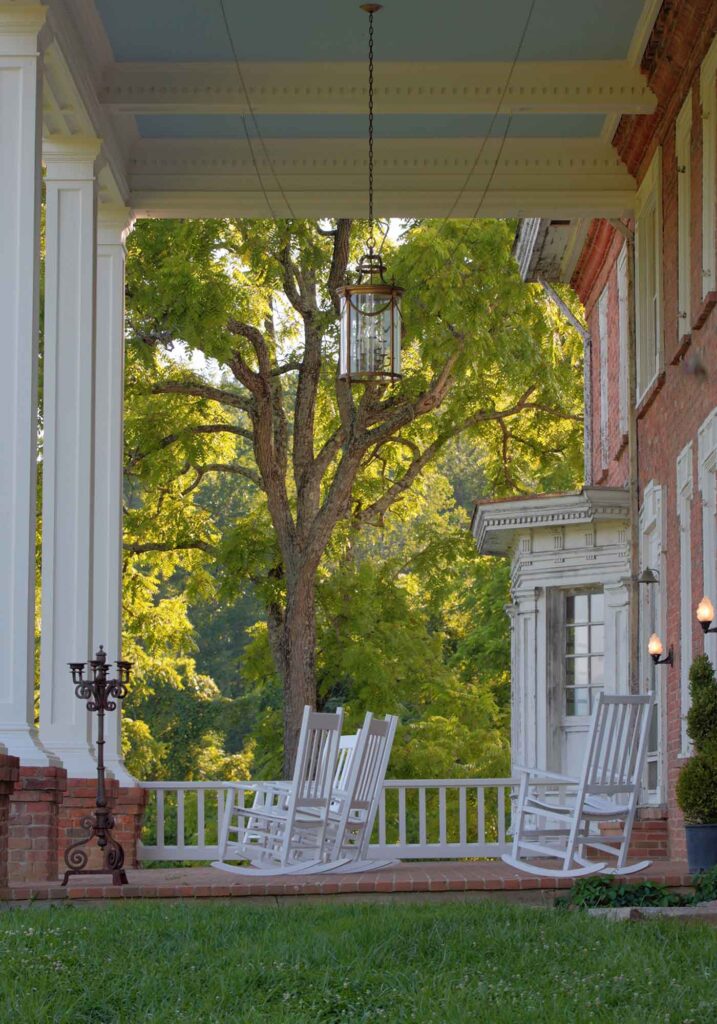
Lexington, Virginia: Academic Prestige and Southern History
Lexington is a jewel of western Virginia, known for its deep academic and military traditions. Home to Washington and Lee University—originally founded as Augusta Academy in 1749—and the Virginia Military Institute, established in 1839, Lexington played a pivotal role in Southern and national history. Its cobblestone streets and preserved 19th-century buildings offer a glimpse into a bygone era. The 2025 Historic Garden Week tour includes five architecturally distinct homes, all within walking distance, highlighting the city’s elegant residential history and enduring cultural appeal.
Historic Garden Tours of Central Virginia
Ashland–New Kent: Colonial Roots and Collegiate Charm in Central Virginia
Ashland–New Kent offers a blend of academic legacy and deep-rooted American history. Ashland is home to Randolph-Macon College, one of the oldest Methodist institutions in the country, lending a collegiate charm to this walkable, historic town. Just east, New Kent County played a prominent role during the colonial and Revolutionary War eras—George Washington famously married Martha Custis at a local church here. This year’s self-driving Historic Garden Week tour features four unique properties: a historic tavern, a stately Federal-style mansion, a family residence, and a manor house, showcasing the region’s architectural and historical diversity.
Historic Route 5: Berkeley, Shirley and Westover Plantations Preserve Virginia’s Colonial Legacy
Along scenic Route 5 in Charles City County lie three of Virginia’s most iconic colonial estates: Berkeley, Shirley, and Westover plantations. These properties, steeped in centuries of history and architecture, open their homes and meticulously maintained gardens each year during Historic Garden Week, sponsored by the Garden Club of Virginia. Proceeds support the preservation of historic gardens statewide. Berkeley Plantation, founded in 1619, is known as the site of the first official Thanksgiving and the birthplace of President William Henry Harrison. Shirley Plantation, established in 1613, is America’s oldest family-owned business, continuously operated by the Hill-Carter family. Westover, a Georgian masterpiece built around 1730 by the Byrd family, remains a private residence and a standout example of period design.
Petersburg, Virginia: Historic High Street and Civil War Landmarks
Once a major transportation hub along the Appomattox River, Petersburg played a key role in both the Revolutionary and Civil Wars. The city is especially known for the Siege of Petersburg (1864–65), a critical campaign that contributed to the fall of Richmond. This year’s tour highlights four distinctive homes and two private gardens in the High Street area of Old Towne Petersburg. The neighborhood, part of the Old Towne Historic District, features an array of 18th- and 19th-century architecture and has evolved into a cultural hotspot, with galleries, cafés, and restored residences anchoring its modern identity.
Fredericksburg–Falmouth: Early American History and Civil War Heritage
Located along the Rappahannock River, Fredericksburg and neighboring Falmouth are steeped in colonial and Civil War history. Historically, Fredericksburg was a vital port and commercial hub during the 18th century, home to key figures such as George Washington and sites like the Fredericksburg and Spotsylvania National Military Park. Falmouth, just across the river, served as a major supply base for Union forces during the Civil War. This year’s tour features privately owned homes that reflect the area’s architectural charm and historic depth, inviting visitors to explore one of Virginia’s most storied regions.
Northern Neck: Waterfront Beauty and Colonial Significance on the Crab Point Peninsula
The Northern Neck, nestled between the Potomac and Rappahannock rivers, is one of Virginia’s most scenic and historically significant regions. Known as the birthplace of George Washington and other American luminaries, the area blends rich colonial heritage with tranquil waterfront living. Notably, this year’s Historic Garden Week tour highlights four private waterfront homes and a garden on the Crab Point Peninsula. With sweeping views of the Rappahannock River and a legacy rooted in agriculture and maritime trade, the peninsula captures the timeless allure of the Northern Neck.
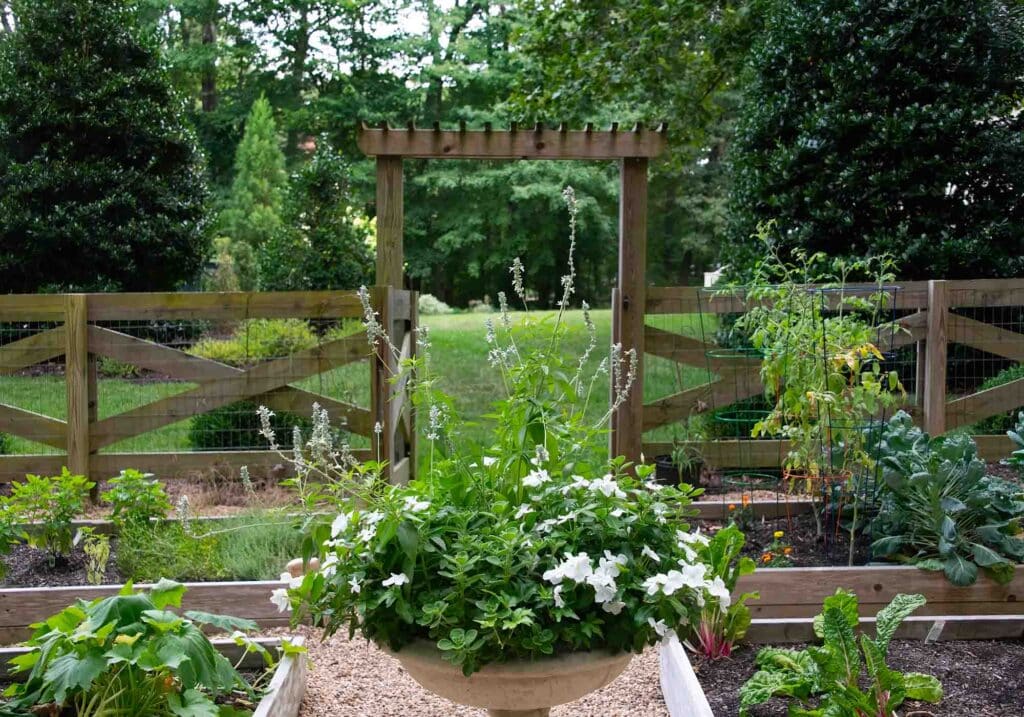
Richmond, Virginia: Historic Neighborhoods Reveal Capital City’s Architectural Legacy
As Virginia’s capital and one of America’s oldest cities, Richmond played pivotal roles in both the Revolutionary War and Civil War. This year’s Historic Garden Week tour explores three architecturally rich neighborhoods: Chatham Hills, Pope Avenue, and Lower Tuckahoe West. Chatham Hills offers suburban tranquility near the James River, while Pope Avenue is known for stately homes and leafy streetscapes. Lower Tuckahoe West, steeped in plantation history, showcases Richmond’s agrarian past and evolving residential charm.
Ultimately, Historic Garden Week offers an unforgettable opportunity to experience Virginia’s vibrant spring landscape at its peak. It’s a rare chance to explore the Commonwealth’s most historic gardens while gaining insight into the ongoing restoration efforts supported by the Garden Club of Virginia. Proceeds from ticket sales directly fund the preservation of these treasured spaces. Tickets for individual tours, as well as the discounted FLOWER Magazine State Pass, are available online.
For even more garden inspiration, visit the Lynchburg Home & Garden of Harlem Renaissance poet Anne Spencer, browse highlights from the 2024 Historic Garden Week or bring the charm home by planting Virginia garden favorites like lavender, wisteria and hydrangea—or even try your hand at raising backyard chickens. ~

